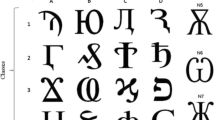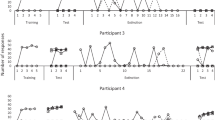Abstract
To establish a series of derived relations between arbitrary stimuli, 20 subjects were exposed to nonarbitrary and arbitrary relational training and testing procedures. Subjects were then exposed to an avoidance conditioning procedure in which one member from each relation was established as a discriminative stimulus for avoidance and nonavoidance, respectively. Subjects who showed conditioned avoidance and nonavoidance also showed derived avoidance and nonawidance to other relation members. All subjects were then exposed to one of two extinction procedures, in which the original discriminative stimuli or other class members were employed, respectively. The majority of subjects exposed to both procedures also demonstrated spontaneous derived extinction of avoidance responding. These findings may have several important treatment implications.
Similar content being viewed by others
References
AUSTON, E. M., & DOUGHER, M. J. (1997). the transfer of avoidance evoking functions through stimulus equivalence classes. Journal of Behavioral Therapy and Experimental Psychiatry, 28, 181–191.
BARLOW, D. H. (2002). Anxiety and its disorders: The nature and treatment of anxiety and panic (2nd ed.). New York: Guilford Press.
BARLOW, D. H., ALLEN, L. B., & CHOATE, M. L. (2004). Toward a unified treatment for emotional disorders. Behavior Therapy, 35, 205–230.
BARNES, D., & KEENAN, M. (1993). A transfer of functions through derived arbitrary and nonarbitrary stimulus relations. Journal of the Experimental Analysis of Behavior, 59, 61–81.
BARNES, D., & ROCHE, B. (1996). Relational frame theory and stimulus equivalence are fundamentally different: A reply to Sai]ders. The Psychological Record, 46, 489–508.
BARNES, D., & ROCHE, B. (1997). Relational frame theory and the experimental analysis of human sexuality. Applied and Preventive Psychology, 6, 117–135.
BARNES-HOLMES, D., & BARNES-HOLMES, Y. (2000). Explaining complex behavior: Two perspectives on the concept of generalized operant classes. The Psychological Record, 50, 251–265.
COHEN, J. D., MACWHINNY, B., FLATT, M., & PROVOST, J. (1993). PsyScope: A new graphic interactive environment for designing psychology experiments. Behavioral Research Methods, Instruments, and Computers, 25, 257–271.
DE ROSE, J. C., MCLLVANE, W. J., & DUBE, W. V. (1988). Stimulus class formation and functional equivalence in moderately retarded individuals’ conditional discrimination. Behavioural Processes, 17, 167–175.
DOUGHER, M. J., AUGUSTON, E., MARKHAM, M.R., GREENWAY, D.E., & WULFERT, E.W. (1994). The transfer of respondent eliciting and extinction functions through stimulus equivalence classes. Journal of the Experimental Analysis of Behavior, 62, 331–351.
DOUGHER, M. J., & MARKAM, M. R. (1994). Stimulus equivalence, functional equivalence and the transfer of function. In S. C. Hayes, L. J. Hayes, M. Sato, & K. Ono (Eds.), Behavior Analysis of Language and Cognition (pp 71–90). Reno, NV: Context Press.
DYMOND, S., & BARNES, D. (1995). A transfer of self-discrimination response functions in accordance with the arbitrarily applicable relations of sameness, more than, and less than. Journal of the Experimental Analysis of Behavior, 64, 163–184.
DYMOND, S., & REHFELDT, R. (2000). Understanding complex behavior: The transformation of stimulus functions. The Behavior Analyst, 23, 239–254.
DYMOND, S., ROCHE, B., FORSYTH, J.P., WHELAN, R., & RHODEN, J. (2007). Transformation of avoidance response functions in accordance with the relational frames of same and opposite. Journal of the Experimental Analysis of Behavior, 88, 249–262.
FORSYTH, J. P. (2000). A process-oriented behavioral approach to the etiology, maintenance, and treatment of anxiety-related disorders. In M. J. Dougher (Ed.), Clinical behavior analysis (pp. 153–180). Reno, NV: Context Press.
FORSYTH, J. P., & EIFERT, G. H. (1996). Systemic alarms in fear conditioning I: A reappraisal of what is being conditioned. Behavior Therapy, 27, 441–462.
FRIMAN, P. C., HAYES, S. C., & WILSON, K. G. (1994). Why behavior analysts should study emotion: The example of anxiety. Journal of Applied Behavior Analysis, 31, 137–156.
GATCH, M. B., & OSBORNE, J. G. (1989). Transfer of contextual stimulus function via equivalence class development. Journal of the Experimental Analysis of Behavior, 51, 369-378.
GREEN, G., SIGURDARDOTTIR, Z. G., & SDERS, R. R. (1991). The role of instructions in the transfer of ordinal functions through equivalence classes. Journal of the Experimental Analysis of Behavior, 55, 287-304.
HAYES, S. C., & BARNES, D. (1997). Analyzing derived stimulus relations requires more than the concept of stimulus class. Journal of the Experimental Analysis of Behavior, 68, 235-270.
HAYES, S. C., BARNES-HOLMES, D., & ROCHE, B. (2001). (Eds.). Relational Frame Theory: A Post-Skinnerian account of human language and cognition. New York: Plenum Press.
HAYES, S. C., KOHLENBERG, B. S., & HAYES, L. J. (1991). The transfer of specific and general consequential functions through simple and conditional equivalence relations. Journal of the Experimental Analysis of Behavior, 56, 119–137.
HAYES, S. C., STROSAHL, K. D., & WILSON, K. G. (1999). Acceptance and Commitment Therapy: An Experiential Approach to Behavior Change. New York: Guilford Press.
HAYES, S. C., WILSON, K. G., GIFFORD, E. V., FOLLETTE, V. M., & STROSAHL, K. (1996). Experiential avoidance and behavioral disorders: A functional dimensional approach to diagnosis and treatment. Journal of Consulting and Clinical Psychology, 64, 1152–1168.
KOHLENBERG, B. S., HAYES, S. C., & HAYES, L. J. (1991). The transfer of contextual control over equivalence classes: A possible model of social stereotyping. Journal of the Experimental Analysis of Behavior, 56, 505–518.
LANG, P. J., BRADLEY, M. M., & CUTHBERT, B. N. (2001). International affective picture system (Iaps). instruction manual and affective ratings. Technical Report A-5. Center for Research in Psychophysiology, University of Florid
LAZAR, R. (1977). Extending sequence-class membership with matching to sample. Journal of the Experimental Analysis of Behavior, 27, 381–392.
MASUDA, A., HAYES, S. C., SACKETT, C. F., & TWOHIG, M. P. (2004). Cognitive defusion and self-relevant negative thoughts: Examining the impact of a ninety year old technique. Behaviour Research and Therapy, 42, 477–485.
MOWER, O. H. (1960). Learning Theory and Behavior. New York: Wiley
O’HORA, D., BARNES-HOLMES, D., ROCHE, B., & SMEETS, P. M. (2004). Derived relational networks and control by novel instructions: A possible model of generative verbal responding. The Psychological Record, 54, 437–460.
O’HORA, D., ROCHE, B., BARNES-HOLMES, D., & SMEETS, P. M. (2002). Response latencies to multiple derived stimulus relations: Testing two predictions of Relational Frame Theory. The Psychological Record, 52, 51–75.
OTTENBREIT, N. D., & DOBSON, K. S. (2004). Avoidance and depression: The construction of the Cognitive-Behavioral Avoidance Scale. Behaviour Research and Therapy, 42, 293–313.
RACHMAN, S. J. (1977). The conditioning theory of fear acquisition: A critical examination. Behaviour Research and Therapy, 15, 375–387.
RACHMAN, S. (1991). Neo-conditioning and the classical theory of fear acquisition. Clinical Psychology Review, 11, 155–173.
ROCHE, B., & BARNES, D. (1996). Arbitrarily applicable relational responding and sexual categorization: A critical test of the derived difference relation. The Psychological Record, 46, 451-475.
ROCHE, B., & BARNES, D. (1997). A transformation of respondently conditioned stimulus function in accordance with arbitrarily applicable relations. Journal of the Experimental Analysis of Behavior, 67, 275-301.
STEELE, D., & HAYES, S. C. (1991). Stimulus equivalence and arbitrarily applicable relational responding. Journal of the Experimental Analysis of Behavior, 56, 519-555.
WOLPE, J. (1958). Psychotherapy by reciprocal inhibition. Oxford: Stanford University Press
WHELAN, R., & BARNES-HOLMES, D. (2004). The transformation of consequential functions in accordance with the relational frames of same and opposite. Journal of the Experimental Analysis of Behavior, 82, 177–195.
WHELAN, R., BARNES-HOLMES, D., & DYMOND, S. (2006). The transformation of consequential functions in accordance with the relational frames of more-than and less-than. Journal of the Experimental Analysis of Behavior, 86, 317–335.
WULFERT, E., & HAYES, S. C. (1988). Transfer of a conditional ordering response through conditional equivalence classes, Journal of the Experimental Analysis of behavior, 50, 125–1
Author information
Authors and Affiliations
Corresponding author
Rights and permissions
About this article
Cite this article
Roche, B.T., Kanter, J.W., Brown, K.R. et al. A Comparison of “Direct” Versus “Derived” Extinction of Avoidance Responding. Psychol Rec 58, 443–463 (2008). https://doi.org/10.1007/BF03395628
Published:
Issue Date:
DOI: https://doi.org/10.1007/BF03395628




